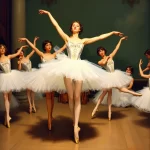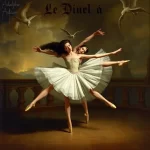Ballet: Josephslegende (Richard Strauss, 1914)

Introduction
Ballet, an art form that combines music, dance, and storytelling, has produced numerous masterpieces over the centuries. One such work is Josephslegende (Joseph’s Legend), a ballet composed by Richard Strauss in 1914. This ballet, choreographed by Léonide Massine, premiered on May 14, 1914, at the Paris Opera. Josephslegende is a one-act ballet that tells the biblical story of Joseph, focusing on themes of temptation, virtue, and divine intervention.
Historical Background
Creation and Development
The early 20th century was a period of significant change and experimentation in the arts. The Ballets Russes, founded by Sergei Diaghilev, was at the forefront of this movement, pushing the boundaries of traditional ballet. It was within this context that Josephslegende was created. Diaghilev commissioned Richard Strauss, a leading composer of the time, to write the score. The inspiration for the ballet came from the biblical story of Joseph and Potiphar’s wife, a tale rich in dramatic potential.
The collaboration between Strauss and Massine was crucial to the development of the ballet. Strauss’s music, known for its lush orchestration and complex harmonies, provided a rich backdrop for Massine’s innovative choreography. Other key figures involved in the production included set designer Léon Bakst and costume designer José Maria Sert, both of whom contributed to the ballet’s visual splendor.
Premiere and Reception
Josephslegende premiered on May 14, 1914, at the Paris Opera. The initial reception was mixed; while some critics praised the ballet’s boldness and innovation, others found it overly complex and difficult to follow. Despite this, the ballet garnered attention for its ambitious scope and the high caliber of its production.
Notable early performances included revivals by the Ballets Russes and other prominent ballet companies. Over time, Josephslegende has come to be appreciated for its unique blend of music, dance, and storytelling, securing its place in the ballet repertoire.
Synopsis of the Ballet
Josephslegende is a one-act ballet that unfolds in a series of dramatic scenes. The story is set in ancient Egypt and revolves around Joseph, a virtuous young man who becomes the object of desire for Potiphar’s wife.
Key Moments
- Introduction of Joseph: The ballet opens with Joseph being sold into slavery by his jealous brothers. He is bought by Potiphar, a high-ranking Egyptian official.
- Temptation: Potiphar’s wife becomes infatuated with Joseph and attempts to seduce him. Despite her advances, Joseph remains steadfast in his virtue.
- False Accusation: Frustrated by Joseph’s rejection, Potiphar’s wife falsely accuses him of attempting to seduce her. Joseph is imprisoned as a result.
- Divine Intervention: In the final scene, divine intervention reveals Joseph’s innocence, and he is ultimately vindicated.
Musical Composition
Composer’s Role
Richard Strauss, one of the most influential composers of the early 20th century, brought his unique musical voice to Josephslegende. Known for his operas and tone poems, Strauss’s contribution to the ballet was significant. His score for Josephslegende is characterized by its rich orchestration, complex harmonies, and dramatic intensity.
Musical Themes and Motifs
The music of Josephslegende features several recurring themes and motifs that enhance the narrative. For example, Joseph’s purity and virtue are represented by a serene, lyrical theme, while Potiphar’s wife’s seductive nature is conveyed through more sensuous, chromatic melodies. These musical elements help to underscore the emotional and dramatic arcs of the characters.
Famous Recordings and Performances
Over the years, there have been several notable recordings of Strauss’s score for Josephslegende. Conductors such as Herbert von Karajan and Karl Böhm have brought their interpretations to the music, contributing to its enduring legacy. These recordings continue to be celebrated for their fidelity to Strauss’s vision and their ability to capture the ballet’s dramatic essence.
Choreography and Dance
Choreographer’s Vision
Léonide Massine, a principal choreographer for the Ballets Russes, brought his innovative style to Josephslegende. Massine’s choreography was known for its expressive movement and dramatic intensity, qualities that were well-suited to the story of Joseph. He sought to create a ballet that was both visually stunning and emotionally compelling.
Signature Dance Numbers
One of the standout dance numbers in Josephslegende is the Pas de Deux between Joseph and Potiphar’s wife. This dance encapsulates the tension and drama of their relationship, with movements that convey both seduction and resistance. Another key scene is Joseph’s solo dance, which reflects his inner turmoil and steadfast virtue.
Notable Interpretations
Over the years, different productions of Josephslegende have brought their own interpretations to the choreography. Some have emphasized the ballet’s dramatic elements, while others have focused on its visual and aesthetic aspects. These varying interpretations have contributed to the ballet’s rich performance history.
Characters and Roles
Main Characters
- Joseph: The protagonist, known for his virtue and integrity. He is a young man who resists the temptations of Potiphar’s wife.
- Potiphar’s Wife: The antagonist, who becomes infatuated with Joseph and attempts to seduce him. Her actions drive the central conflict of the ballet.
- Potiphar: A high-ranking Egyptian official who buys Joseph as a slave. He is initially unaware of his wife’s intentions.
Supporting Characters
- Joseph’s Brothers: They sell Joseph into slavery out of jealousy, setting the story in motion.
- Egyptian Servants: They serve as background characters, contributing to the setting and atmosphere of the ballet.
Famous Dancers
Several notable dancers have portrayed the roles in Josephslegende over the years. Vaslav Nijinsky, one of the most famous dancers of the early 20th century, was among the first to perform the role of Joseph. Other renowned dancers, such as Rudolf Nureyev and Mikhail Baryshnikov, have also brought their talents to this challenging role.
Cultural and Artistic Impact
Influence on Ballet and Dance
Josephslegende has had a lasting impact on the world of ballet and dance. Its innovative choreography and complex score have influenced other works and choreographers. The ballet’s emphasis on dramatic storytelling through dance has also contributed to the development of ballet as an expressive art form.
Cultural Significance
The ballet’s themes of virtue, temptation, and divine intervention resonate with audiences and have found their way into popular culture. The story of Joseph has been adapted into various forms, including film, theater, and literature, further cementing its cultural significance.
Legacy and Revivals
Josephslegende continues to be performed and celebrated today. Major revivals and reinterpretations have kept the ballet relevant, allowing new generations to experience its beauty and complexity. Modern adaptations often bring fresh perspectives to the choreography and staging, ensuring that the ballet remains a vital part of the dance repertoire.
Iconic Productions
Historic Productions
One of the most famous historical productions of Josephslegende was its premiere by the Ballets Russes in 1914. This production featured some of the most prominent artists of the time, including Vaslav Nijinsky and Léon Bakst. The collaboration between these artists resulted in a visually and musically stunning performance that set the standard for future productions.
Contemporary Productions
Recent productions of Josephslegende have brought new interpretations to the ballet. Companies such as the Royal Ballet and the Bolshoi Ballet have staged their own versions, incorporating modern elements while staying true to the original vision. These contemporary productions often feature innovative set and costume designs, as well as updated choreography.
Production Design
The set, costume, and lighting design play a crucial role in bringing Josephslegende to life. Historic productions often featured elaborate sets and costumes designed by artists like Léon Bakst and José Maria Sert. Modern productions continue this tradition, using advanced technology and creative design to enhance the visual impact of the ballet.
Critical Reception and Reviews
Initial Critical Response
The initial critical response to Josephslegende was mixed. While some critics praised the ballet’s boldness and innovation, others found it overly complex and difficult to follow. Despite this, the ballet garnered attention for its ambitious scope and the high caliber of its production.
Modern Reviews
Contemporary critics and audiences have come to appreciate Josephslegende for its unique blend of music, dance, and storytelling. The ballet is often praised for its dramatic intensity and the richness of its score. Modern reviews highlight the ballet’s enduring relevance and its ability to captivate audiences with its timeless themes.
Fun Facts and Trivia
Behind-the-Scenes Stories
One interesting anecdote from the production of Josephslegende involves Vaslav Nijinsky, who was initially cast as Joseph. Nijinsky’s intense dedication to his role reportedly led him to practice for hours on end, perfecting every movement. His commitment to the character contributed to the ballet’s dramatic impact.
Notable Performers
Over the years, many famous dancers have taken on the roles in Josephslegende. In addition to Nijinsky, dancers such as Rudolf Nureyev and Mikhail Baryshnikov have brought their talents to the role of Joseph. These performers have left their mark on the ballet, each bringing their unique interpretation to the character.
Trivia
- Richard Strauss: Strauss composed the score for Josephslegende in just a few months, showcasing his remarkable talent and creativity.
- Choreographic Innovations: Léonide Massine’s choreography for Josephslegende was groundbreaking at the time, incorporating elements of modern dance and expressive movement.
- Visual Splendor: The original production featured elaborate sets and costumes designed by Léon Bakst and José Maria Sert, adding to the ballet’s visual appeal.
Conclusion
Summary of the Ballet’s Importance
Josephslegende is a significant work in the world of ballet, known for its innovative choreography, rich musical score, and dramatic storytelling. The collaboration between Richard Strauss and Léonide Massine resulted in a ballet that continues to captivate audiences with its timeless themes and artistic excellence.
Final Thoughts
Josephslegende remains a testament to the power of collaboration and creativity in the arts. Its enduring legacy is a testament to the talents of its creators and performers. For those who have not yet experienced this ballet, it is highly recommended to watch a performance or listen to the score to fully appreciate its beauty and complexity.
FAQ
What is the central theme of this ballet?
The central theme of Josephslegende is the struggle between virtue and temptation, as exemplified by the story of Joseph and Potiphar’s wife.
Who are the main characters in this ballet?
The main characters are Joseph, Potiphar’s wife, and Potiphar.
What is the most famous dance number in this ballet?
The Pas de Deux between Joseph and Potiphar’s wife is one of the most famous dance numbers in Josephslegende.
How long does a typical performance of this ballet last?
A typical performance of Josephslegende lasts approximately 45 minutes to an hour.
Are there any modern adaptations of this ballet?
Yes, there have been several modern adaptations and revivals of Josephslegende, incorporating contemporary elements while staying true to the original vision.
Why is this ballet considered important in the history of dance?
Josephslegende is considered important for its innovative choreography, rich musical score, and its role in pushing the boundaries of traditional ballet. It has influenced other works and continues to be celebrated for its artistic excellence.





